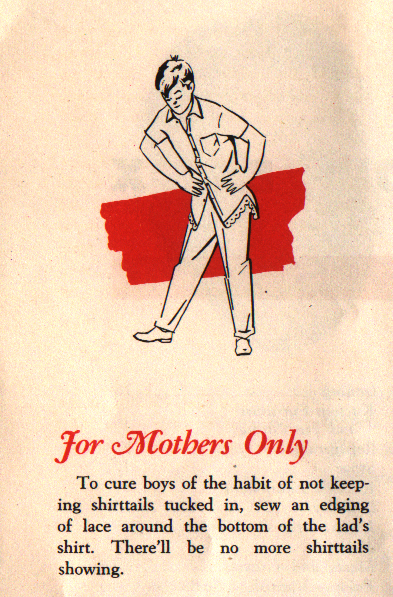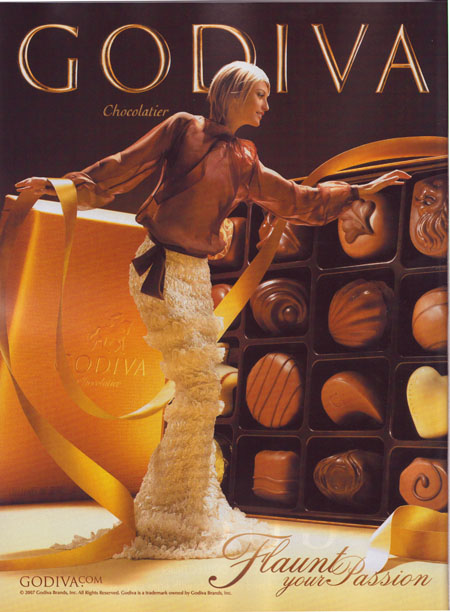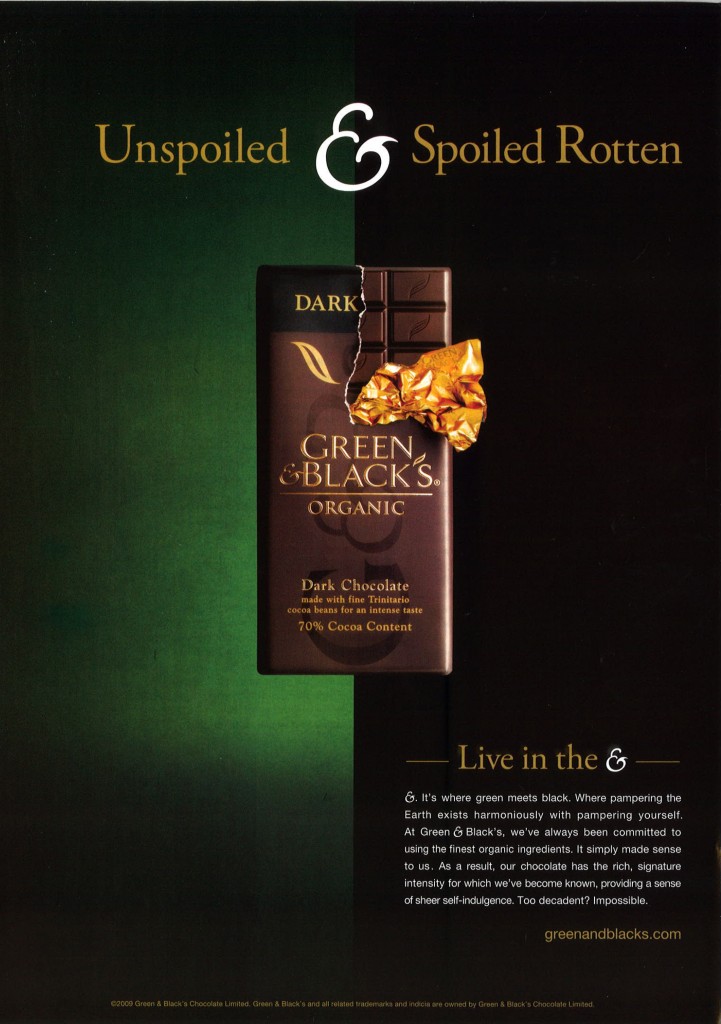Lauren McGuire sent along a BoingBoing link to this page from a booklet called Hint Hunt (1940s). It advises mothers to “inspire” their sons to tuck in their shirts by sewing (hideously embarrassing) lace along the bottom:
Lisa Wade, PhD is an Associate Professor at Tulane University. She is the author of American Hookup, a book about college sexual culture; a textbook about gender; and a forthcoming introductory text: Terrible Magnificent Sociology. You can follow her on Twitter and Instagram.In consumer society, products sell an image of the consumer to others. Chocolate, for example, can bring prestige if it comes from a particular manufacturer and falls within a certain price range. The design and ideology behind Godiva for example, promotes a sophisticated chocolate and uses powerful imagery to convince consumers that they may attain an unparalleled experience of high-class luxury.
Godiva promotes the idea that consumers of their chocolates are somehow “higher class” and more “tasteful” than people who do not consume them. As a result, their chocolates have a higher exchange value than the everyday, $1 chocolates meant for middle and lower-class consumers.
Many chocolate connoisseurs argue that Godiva chocolates taste like sugar and candle wax, failing to satisfy the European taste criteria for elite chocolate. Nevertheless, the reputation of Godiva as luxurious is enough to satisfy many non-connoisseurs and it, accordingly, maintains a high exchange-value. Hoping to capitalize on the trend, many popular brands have released their own line of “premium” chocolates hoping to reap profits far out of proportion to the cost of production.
From a Marxist viewpoint, status-symbol chocolate advertising exemplifies how fetishization helps maintain capitalism. Such advertising tacitly legitimizes the elite class by reinforcing the image of upper-class superiority and by presenting the luxurious lifestyle as something to aspire to. It also helps foster false consciousness, which lulls the oppressed working class into complicity, even or especially when prices for “premium” chocolates fall suspiciously low.
Is fair trade a resolution to chocolate’s fetishism?
Chocolate’s fetishism is partially resolved through Fair Trade, which redistributes some of those profits back to the working class and makes the consumer conscious of the worker.
The fetishism of chocolate is only partly resolved, however, since the owning class continues to profit from the fetishism of the commodity and from the enhancing status of the “Fair Trade” label. The purchasing of Fair Trade chocolate, you see, provides the consumer with some emotional comfort; it flatters them just as a high end chocolate product flatters buyers who identify themselves as elite. Therefore, there is an increase in the consumer’s cultural capital with the purchase of Fair Trade chocolate. It is still fetishism to the extent that the consumer is purchasing a comforting emotion or an image of themselves saving the world, which is encouraged by advertising campaigns and wrapper designs. However, in an interesting twist, fetishism is used to reverse the effects that it is traditionally guilty of: benefiting the upper-class at the expense of the lower-class.
————————-
Jamal Fahim graduated from Occidental College in 2010 with a major in Sociology and a minor in Film and Media Studies. He was a member and captain of the Occidental Men’s Tennis team. Jamal currently lives in Los Angeles with the intention of working in the film industry as a producer. His interests include film, music, digital design, anime, Japanese culture, improvising, acting, and of course, chocolate!
If you would like to write a post for Sociological Images, please see our Guidelines for Guest Bloggers.
Lisa Wade, PhD is an Associate Professor at Tulane University. She is the author of American Hookup, a book about college sexual culture; a textbook about gender; and a forthcoming introductory text: Terrible Magnificent Sociology. You can follow her on Twitter and Instagram.In an old post on the idea of cool, I summarized Susan Bordo’s observations in Twilight Zones:
…the art of being cool is appearing not to care… what marked someone as cool was their complete disinterest in you, everything you stand for and, especially, what you thought of them. Being cool is not being needy.
I was reminded of this idea when Ali S., M., Hishaam S., Dmitriy T.M., and Alian K. passed along a set of ads for a Dutch clothing company, Suit Supply. Lauri Apple at Jezebel writes that they’re “creepy and porno-like” and I think it is the cool factor that makes them so. Notice how disinterested most of the characters, especially the men, appear to be. He lounges on the couch, entirely unaffected by the imminent humping behind him. They screw on the kitchen counter, like it’s their same ol’ boring routine. He casually lifts up her skirt, like it’s no big thing.
More (some not safe for work) after the jump:
Lisa Wade, PhD is an Associate Professor at Tulane University. She is the author of American Hookup, a book about college sexual culture; a textbook about gender; and a forthcoming introductory text: Terrible Magnificent Sociology. You can follow her on Twitter and Instagram.Enjoy Jennifer Lee, professor of sociology at UC Irvine, discussing how the American concept of race has been changing as we’re confronted with a more complex racial landscape. Are we forcing all racial groups into the pre-existing black/white binary? A white/non-white binary? A black/non-black binary? Or something else?
Lisa Wade, PhD is an Associate Professor at Tulane University. She is the author of American Hookup, a book about college sexual culture; a textbook about gender; and a forthcoming introductory text: Terrible Magnificent Sociology. You can follow her on Twitter and Instagram.BoingBoing reports on a BBC site, based on research by Psychologist Paul Ekman, where you can test your ability to detect fake smiles. It turns out, most people are “surprisingly bad” at differentiating genuine from fake smiles. Take the test or read more on how to spot fake smiles (after the jump).
According to the study summary, most people are very bad at detecting fake vs. genuine smiles, though there are tell-tale signs:
Fake smiles can be performed at will, because the brain signals that create them come from the conscious part of the brain and prompt the zygomaticus major muscles in the cheeks to contract. These are the muscles that pull the corners of the mouth outwards.
Genuine smiles, on the other hand, are generated by the unconscious brain, so are automatic. When people feel pleasure, signals pass through the part of the brain that processes emotion. As well as making the mouth muscles move, the muscles that raise the cheeks – the orbicularis oculi and the pars orbitalis – also contract, making the eyes crease up, and the eyebrows dip slightly.
Lines around the eyes do sometimes appear in intense fake smiles, and the cheeks may bunch up, making it look as if the eyes are contracting and the smile is genuine. But there are a few key signs that distinguish these smiles from real ones. For example, when a smile is genuine, the eye cover fold – the fleshy part of the eye between the eyebrow and the eyelid – moves downwards and the end of the eyebrows dip slightly.
I guessed about 50% of the smiles correctly, which is exactly chance. Oddly, I found myself suspecting that they were all faking. I wonder what that says about me!
Lisa Wade, PhD is an Associate Professor at Tulane University. She is the author of American Hookup, a book about college sexual culture; a textbook about gender; and a forthcoming introductory text: Terrible Magnificent Sociology. You can follow her on Twitter and Instagram.The World Economic Forum recently released its Global Gender Gap Report for 2010, authored by Ricardo Hausmann (Harvard University), Laura Tyson (UC Berkeley), and Saadia Zahidi (World Economic Forum). The report ranks countries according to concrete measures of gender inequality. They write:
The Global Gender Gap Index… is a framework for capturing the magnitude and scope of gender-based disparities and tracking their progress. The Index benchmarks national gender gaps on economic, political, education – and healthbased criteria, and provides country rankings that allow for effective comparisons across regions and income groups, and over time.
You can read about their methods, in depth, in the Report.
Here are the rankings:
Lisa Wade, PhD is an Associate Professor at Tulane University. She is the author of American Hookup, a book about college sexual culture; a textbook about gender; and a forthcoming introductory text: Terrible Magnificent Sociology. You can follow her on Twitter and Instagram.An iVillage slide show featuring birth control advice for women, sent in by Corina C., is a good demonstration of the norming of a particular life course. First, organized by the decade of life, the slide show starts with women in their 20s. No sex for teenagers (at least not any that the slide show is going to acknowledge).
“In Your 20s… Because You Need to Get in the Habit”:
Second, the slide show assumes that women will be having children in their 30s, not in their 20s, and not in their 40s.
“In Your 30s… Because You’ll Want to Start a Family Soon” (not maybe or if):
“In Your 40s… Once You’re Through Making Babies” (reiterating that you will have babies and also that you’ll be finished by then):

Finally, the slide show acknowledges and even embraces the possibility of a relationship ending, presumably due to death or divorce (but apparently only after those kids are up and out of the house).
“At 50 and Beyond… When You Start a New Relationship”:

By organizing birth control needs according to age, the slide show teaches viewers a socially-approved timeline for our sexual, marital, and reproductive lives. Teen sex is invisible, having children in your 30s is ideal, and the end of a relationship is an option but, as Corina points out, not having children is not.
Lisa Wade, PhD is an Associate Professor at Tulane University. She is the author of American Hookup, a book about college sexual culture; a textbook about gender; and a forthcoming introductory text: Terrible Magnificent Sociology. You can follow her on Twitter and Instagram.Last year Gwen posted about Medal of Honor, a World War II based video game that featured an all white cast. In her post, she gives numbers as to the diversity of the U.S. military at that time. Here, I offer some photographs of Black American soldiers during the war (borrowed from The History Place):


























